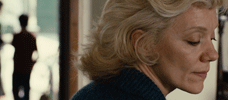Reviews
Kelly Reichardt
USA, 2008
Credits
Review by Leo Goldsmith
Posted on 28 September 2008
Source Oscilloscope Laboratories 35mm Print
Categories The 46th New York Film Festival
One of my very few, utterly pointless quibbles about Kelly Reichardt’s last film, Old Joy, was the dog: Two dudes hang out in the woods around Portland for a couple of days - hiking and talking about stuff and, you know, hanging out - and they bring a dog with them. But they hardly talk to it, suggesting that they are either hopelessly callous men or secretly “cat people” (or both). In such an intimate and intense situation - a “two-men-and-a-doggie tent” - a closely knit trio like Kurt, Mark, and Lucy would necessarily find each of its members on equal footing. This is true especially while camping, when a dog’s instincts, fidelity, and perspicacity are at an apex. It seemed to me while watching Old Joy that Lucy would not likely be merely tagging along for the ride with the more interesting central characters, she would in fact be the more interesting central character. She would at least be more affectionate, sociable, watchful, courageous, and sensitive than Kurt and Mark.
But admittedly Reichardt’s film is about these two characters precisely because of their general lack of these qualities. And to be fair, part of my reaction to Old Joy - which is in any case a beautifully rendered, delicately paced, and acutely pitched film that should be seen by everyone - is due to the uneasiness I feel at recognizing parts of myself and others of my “demo” in the two human (male) characters: Perhaps I feel as though, faced with the awkwardness of hanging out with an old, estranged friend, I’d rather spend quality time with the dog. Miraculously, though, Reichardt has somehow received my subliminal quibbling and made a new film, Wendy and Lucy, that casts a dog in a title role, opposite Michelle Williams.
Lucy is, in fact, the same dog, Reichardt’s own gorgeous tan mutt, whose charisma is enough to match that of her redoubtable co-star. Extraordinarily understated, Williams gives a tangible, if taciturn performance as Wendy, a twentysomething woman traversing the country en route to Alaska, where she hopes to find work at a cannery. With just five hundred dollars, a (very) used car, and a faithful dog to her name, Wendy is living close to the bone, and Williams’ portrayal balances toughness with vulnerability, expressing her dreams and disappointments with the lightest of touches.
From the outset, Reichardt places her protagonist in a uniquely American context, beginning (and thereafter occasionally punctuating) her film with shots of freightcars and railyards. These are points of departure and intersection, but also a means of transportation for the impoverished. (One thinks of Reichardt’s producer, Todd Haynes, here, and his film about Bob Dylan, one of the few American artists to consistently take poverty as a theme of his work, however romantically.) Setting out in its own train-like manner, the camera tracks along at length with Wendy as she tosses a stick to Lucy, who gleefully runs away and returns, runs away and returns. As the autumnal light begins to fade, Wendy briefly loses track of Lucy, only to find her again in a sort of makeshift bacchanal for young transients, who give her a little advice about the best places to find work in Alaska. The tone here and throughout the film is equivocal - a little welcoming, a little threatening - but it is clear that Wendy, alone as she is, is not the only marginalized soul wandering about the country in search of a better life.
Of course, these dreams of the Alaskan good life are derailed in Portland (or thereabouts) when Wendy’s car breaks down, she’s nabbed for shoplifting, and Lucy goes astray. Destitute and adrift, Wendy is forced, in part, to rely on others - a kindly parking lot security guard, a local mechanic, the attendant at the dog pound - but even the help of others is of limited use and not much comfort. Tight-lipped and defensive throughout, Wendy rarely allows the audience (and much less the few characters she comes across) any awareness of her emotions, but for a few outbursts of frustrations, curt attacks, or urgent pleas. Another nocturnal encounter with a railway tramp - this one much more menacing - leaves her in a possum-like crouch; the small kindnesses of the parking lot attendant are responded with cautious, even slightly begrudging gratitude. Above all, it seems, Wendy feels the shame of accepting charity and the help of others, faced as she is with a sense of her own failure, her inability to care for the one thing that mattered to her, her only responsibility.
As if to illustrate this, the camera tracks again - now in the opposite direction - past the diminutive prison cells of the local pound, where lost dogs of every variety lie in wait to be claimed or else forgotten. In this persistent way, Sam Levy’s cinematography follows Wendy too - keeping a steady watch, waiting for moments of expressivity, and inviting the spectator to read into her silence - a much more assured and thoughtful approach than Peter Sillen’s slightly forced, faux-documentary shooting in Old Joy. The camerawork thus conveys a slightly more commanding, authorial presence than in the prior film, as do Reichardt’s subtle invocations of politics and current events. The filmmaker has said that, in writing the film, she and co-writer Jon Raymond (who also co-wrote Old Joy and upon whose short stories both films are based) drew some inspiration from the fall-out of Hurricane Katrina and what it revealed about poverty in America. This suggestion of politics is not quite so up-front, nor so oblique, as Mark’s NPR listening in Old Joy; rather it’s more a faint air of a particularly American milieu: chain-stores, bottle depositories, gas-station bathrooms. We meet Wendy in transit and are given very little back-story—she has a sister and brother-in-law back at home, also undergoing hard times financially, but they are only disconnected voices on the other end of a payphone. But from all of these minute hints, it is clear that, like the most immediate victims of Katrina, Wendy is a kind of refugee, subsisting perilously close to the edge of disaster, hunger, and permanent transience. A car breaking down, a lost dog, a town with no jobs—these are mundane points in a mundane America, but they are Wendy’s world in its entirety, a floating world that we glimpse briefly before it moves on.
More The 46th New York Film Festival
-

Wendy and Lucy
2008 -

The Northern Land
2008 -

The Last Command
1928 -

Hunger
2008 -

Lola Montès
1955 -

Summer Hours
2008 -

Gomorrah
2008 -

Changeling
2008 -

Che
2008 -

I’m Gonna Explode
2008 -

Waltz with Bashir
2008 -

Happy-Go-Lucky
2008 -

The Windmill Movie
2008 -

Tulpan
2008 -

Afterschool
2008 -

A Christmas Tale
2008 -

The Headless Woman
2008 -

Bullet in the Head
2008 -

Four Nights with Anna
2008 -

Night and Day
2008 -

The Class
2008
We don’t do comments anymore, but you may contact us here or find us on Twitter or Facebook.



